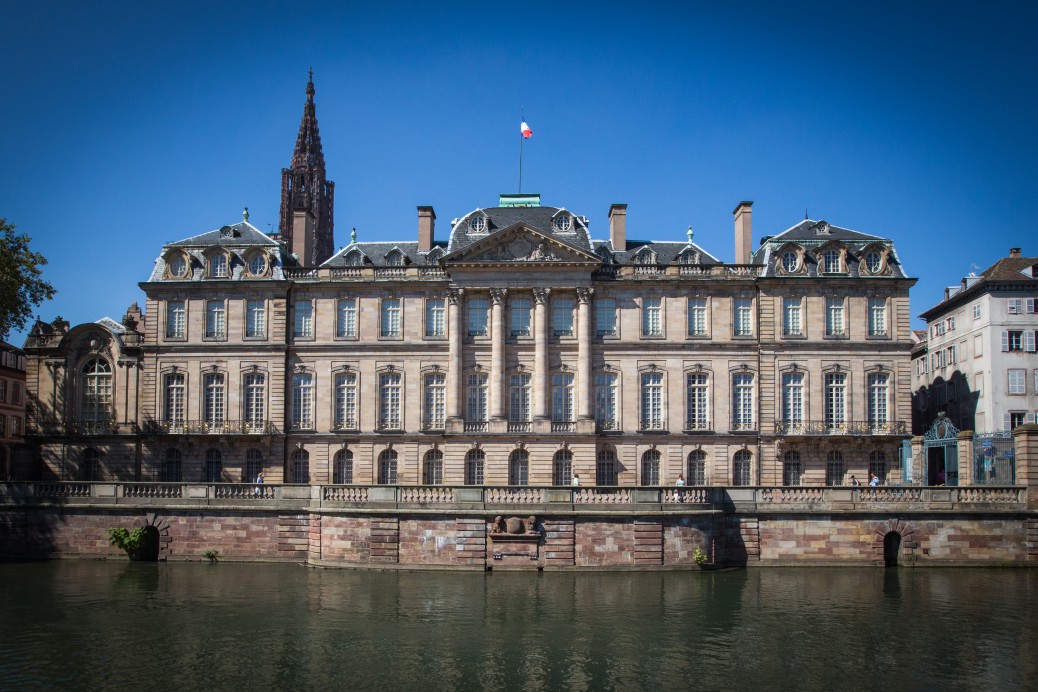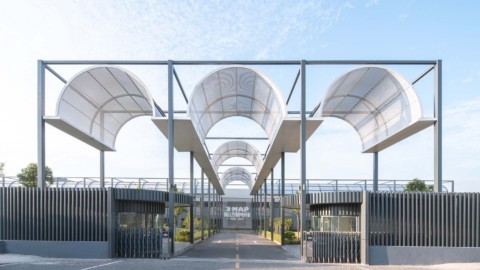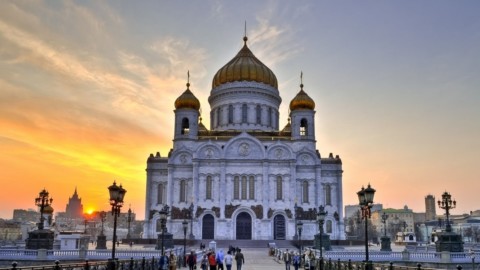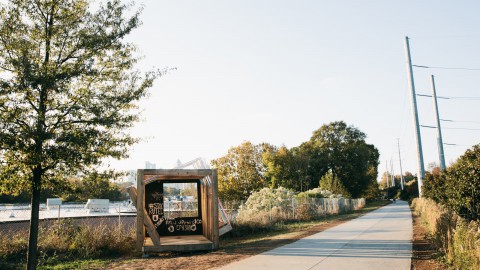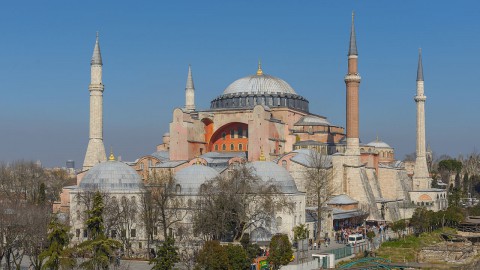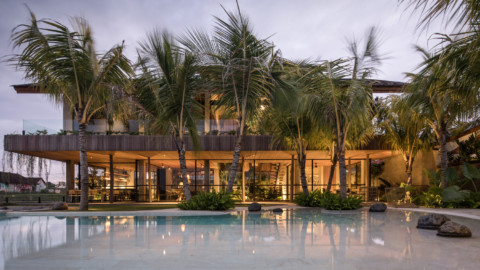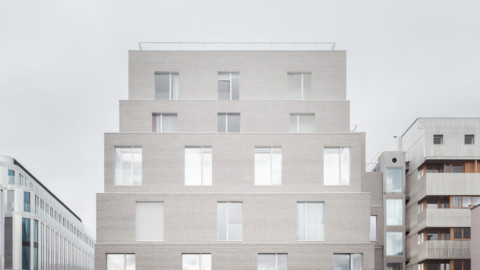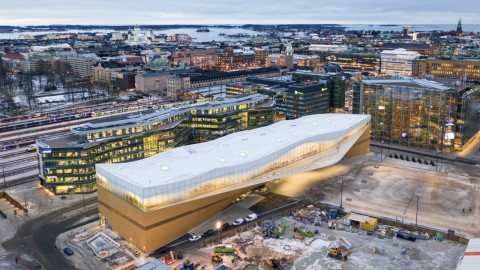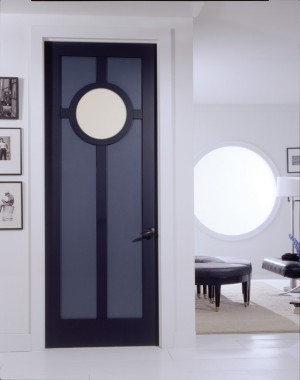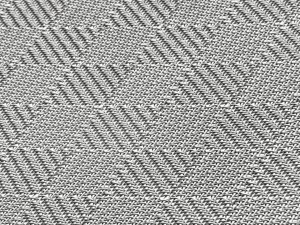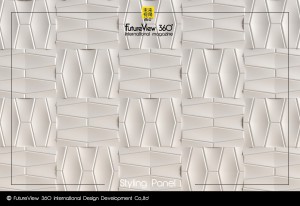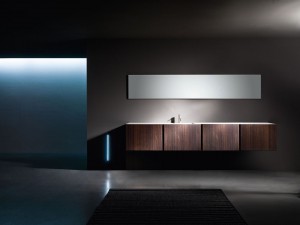Palais Rohan Strasbourg 羅昂宮
From: https://en.wikipedia.org/wiki/Palais_Rohan,_Strasbourg
Location of Palais Rohan
Alternative names Palais des Rohan, Palais des Rohans
General information
Type Palace
Architectural style Baroque
Location Strasbourg, France
Address 2, place du Château, 67000 Strasbourg
Coordinates 48°34′51″N 7°45′08″ECoordinates: 48°34′51″N 7°45′08″E
Current tenants Archaeological Museum, Museum of Fine Arts, Museum of Decorative Arts
Construction started 1732
Completed 1742
Owner Municipality of Strasbourg
Design and construction
Architect Robert de Cotte, Joseph Massol
Palais Rohan的位置
替代名稱Palais des Rohan,Palais des Rohans
一般信息
鍵入宮
建築風格巴洛克風格
位置法國斯特拉斯堡
地址2,地址duChâteau,67000 Strasbourg
坐標48°34’51“N 7°45’08”ECoordinates:48°34’51“N 7°45’08”E
現有租戶考古博物館,美術館,裝飾藝術博物館
施工於1732年開始
已完成1742
斯特拉斯堡的所有者市政府
設計和施工
建築師Robert de Cotte,Joseph Massol
The Palais Rohan (Rohan Palace) in Strasbourg is the former residence of the prince-bishops and cardinals of the House of Rohan, an ancient French noble family originally from Brittany. It is a major architectural, historical, and cultural landmark in the city. It was built next to Strasbourg Cathedral in the 1730s, from designs by Robert de Cotte, and is considered a masterpiece of French Baroque architecture. Since its completion in 1742, the palace has hosted a number of French monarchs such as Louis XV, Marie Antoinette, Napoleon and Joséphine, and Charles X.
Reflecting the history of Strasbourg and of France, the palace has been owned successively by the nobility, the municipality, the monarchy, the state, the university, and the municipality again. Its architectural conception and its iconography were intended to indicate the return of Roman Catholicism to the city, which had been dominated by Protestantism for the previous two centuries. Thus the prelate’s apartments face the cathedral, to the north, and many of the statues, reliefs and paintings reflect the Catholic dogma.
Since the end of the 19th century the palace has been home to three of Strasbourg’s most important museums: the Archaeological Museum (Musée archéologique, basement), the Museum of Decorative Arts (Musée des arts décoratifs, ground floor) and the Museum of Fine Arts (Musée des beaux-arts, first and second floor). The municipal art gallery, Galerie Robert Heitz, in a lateral wing of the palace, is used for temporary exhibitions. The Palais Rohan has been listed since 1920 as a Monument historique by the French Ministry of Culture.
位於斯特拉斯堡的Palais Rohan(Rohan Palace)是Rohan House王子主教和紅衣主教的故居,這是一個源自布列塔尼的古老法國貴族家庭。這是該市的主要建築,歷史和文化地標。 它建於17世紀30年代斯特拉斯堡大教堂旁,由羅伯特·德科特設計,被認為是法國巴洛克式建築的傑作。自1742年建成以來,這座宮殿已經接待了許多法國君主,如路易十五,瑪麗安托瓦內特,拿破崙和約瑟芬,以及查理十世。
這座宮殿反映了斯特拉斯堡和法國的歷史,再次由貴族,市政府,君主制,國家,大學和市政府所擁有。它的建築概念和它的圖像旨在表明羅馬天主教回歸到這個城市,這個城市在過去的兩個世紀裡一直由新教主義。因此,主教的公寓面向大教堂,北面,許多雕像,浮雕和繪畫反映了天主教的教條。
自19世紀末以來,宮殿一直是斯特拉斯堡三個最重要的博物館的所在地:考古博物館(Muséearchéologique,地下室),裝飾藝術博物館(Muséedesartsdécoratifs,底層)和美術博物館。 (Muséedesbeaux-arts,一樓和二樓)。市政藝術畫廊Galerie Robert Heitz位於宮殿的側翼,用於臨時展覽。 Palais Rohan自1920年以來被法國文化部列為紀念碑歷史
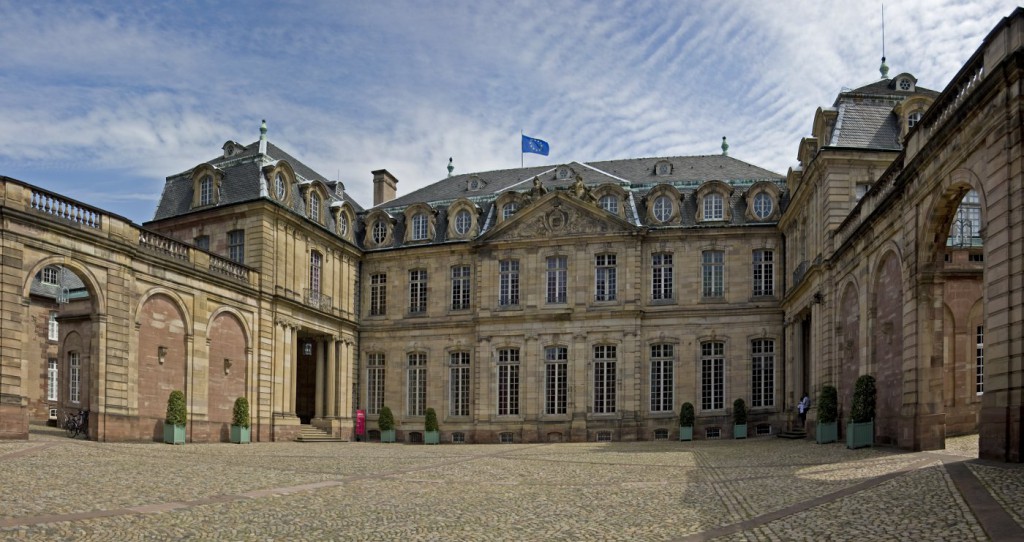
History
Up to 1871
In 1727 Armand Gaston Maximilien de Rohan, bishop of Strasbourg since 1704 and cardinal since 1712, commissioned the architect Robert de Cotte to design the palace; de Cotte provided initial plans the same year. Seven years prior, in 1720, Cardinal de Rohan had already charged de Cotte with renovation and embellishment works on his castle in Saverne, the predecessor of the current Rohan Castle. De Cotte had also previously designed the Hôtel du grand Doyenné, the first hôtel particulier in Louis Quinze style built in Strasbourg. The Palais Rohan was built on the site of the former residence of the bishop, the “bishop’s demesne”, which is recorded since at least 1262. The area itself is near the heart of the ancient Argentoratum, first mentioned in 12 BC. Diverse archaeological excavations on Place du Château, the square facing the palace, have unearthed many remains of the Roman camp.
Building work on the Palais Rohan took place from 1732 until 1742 under the supervision of the municipal architect Joseph Massol, who also worked on the Hôtel de Hanau and the Hôtel de Klinglin during the early years of the project. Massol was assisted by the architects Laurent Gourlade and Étienne Le Chevalier. The sculptures, including statues as well as reliefs, were provided by Robert Le Lorrain, assisted by Johann August Nahl, Gaspard Pollet, and Laurent Leprince, and the paintings by Pierre Ignace Parrocel and Robert de Séry The ébéniste Bernard Kocke and the ironworkers and locksmiths Jean-François Agon and his son Antoine Agon worked on the furnishings of the apartments, while the stucco was the work of the Italians Castelli and Morsegno. A budget of 344,000 French livres had been established for the construction – 200,000 livres lent from the Cathedral chapter (Grand Chapitre) and 144,000 raised as local taxes over a period of twelve years – but the final cost is estimated at one million French livres.The palace is mostly built in yellow sandstone from Wasselonne, with pink sandstone for the less visible parts.
The House of Rohan owned the palace until the French Revolution, when it was confiscated, declared bien national (“state owned”), and finally auctioned off on 8 August 1791. Bought by the municipality, it became the new town hall (hôtel de ville) the same year, succeeding the Neubau. Much of the furniture and many of the works of art in the Palais were sold, and in 1793 the eight life-sized mural portraits of prince-bishops decorating the Salle des évêques (Bishops’ Hall) were destroyed. They were replaced in 1796 by allegories of civic virtues painted by Joseph Melling. Only the portrait of Armand Gaston, the builder of the palace, was later restored to its original place with a 1982 replica of Hyacinthe Rigaud’s lost painting. Melling also replaced the overdoor portraits of kings of France, decorating the same room with paintings of vases.
The Palais Rohan remained the hôtel de ville until 1805. That year, the municipality presented it to Napoleon, who returned the Hôtel de Hanau in exchange. Like the palace, the hôtel had been state-owned since the Revolution. The 1805 arrangement proved favourable for the municipality: the maintenance of the Hôtel de Hanau was less costly than that of the larger Palais Rohan. It pleased Napoleon, for whom the palace was the more conspicuous display of grandeur. As for the palace, imperial ownership meant renewed splendour. The present to Napoleon was officially accepted by decree on 21 January 1806 the interiors were then refurbished by the architect Pierre-François-Léonard Fontaine. In the years before the Franco-Prussian War and the return of Alsace to Germany, the Palais Rohan was the property of the French state, which was in turn an empire, a kingdom, a monarchy, a republic, and again an empire.
歷史
直到1871年
1727年,自1704年起擔任斯特拉斯堡主教的Armand Gaston Maximilien de Rohan以及自1712年以來的紅衣主教,委託建築師Robert de Cotte設計宮殿; de Cotte在同一年提供了初步計劃。七年前,在1720年,紅衣主教德羅漢已經指控de Cotte在他現在的Rohan城堡的前身Saverne的城堡進行翻新和點綴。 De Cotte此前還設計了HôteldugrandDoyenné,這是斯特拉斯堡建造的Louis Quinze風格的第一家酒店。 Palais Rohan建在主教的故居,“主教的demesne”,至少從1262年開始記錄。該地區本身靠近古代Argentoratum的心臟,最早在公元前12年提到。在城堡廣場(PlaceduChâteau)上進行了多樣化的考古發掘,朝向宮殿的廣場上出土了許多羅馬營地的遺跡。
羅漢宮的建築工作於1732年至1742年在市政建築師約瑟夫馬索爾的監督下進行,他在項目的早期階段也曾在哈瑙酒店和克林林酒店工作過。 Massol由建築師Laurent Gourlade和ÉtienneLeChevalier協助。雕塑,包括雕像和浮雕,由Robert Le Lorrain提供,由Johann August Nahl,Gaspard Pollet和Laurent Leprince協助,以及Pierre Ignace Parrocel [和]和RobertdeSéry的繪畫,ébénisteBernardKocke和鋼鐵工人和鎖匠Jean-FrançoisAgon和他的兒子Antoine Agon負責公寓的陳設,而灰泥則是意大利人Castelli和Morsegno的作品。建造了344,000法國里弗的預算 – 從大教堂章節(Grand Chapitre)借出200,000里弗,在12年期間從地方稅收中提取144,000里弗 – 但最終費用估計為100萬法國里弗。宮殿主要建在Wasselonne的黃色砂岩中,粉紅色的砂岩為不太明顯的部分。
Rohan之家擁有宮殿,直到法國大革命被沒收,宣佈為全國(“國有”),並最終於1791年8月8日拍賣。由市政府買下,它成為新的市政廳(hôtelde ville)同年,繼Neubau之後。宮殿中的大部分家具和許多藝術品都被出售,並且在1793年,八尊真人大小的裝飾Salledesévêques(Bishops’Hall)的王子主教的壁畫肖像被摧毀。他們在1796年被約瑟夫·梅林(Joseph Melling)繪製的公民美德的寓言所取代。只有宮殿的建造者阿爾芒加斯頓的肖像後來被恢復到原來的地方,1982年復制了Hyacinthe Rigaud失去的畫作。 Melling還取代了法國國王的過度肖像畫,用花瓶畫裝飾同一個房間。
Palazzo Rohan一直到1805年仍然是酒店。當年,市政當局將它交給了拿破崙,後者又回到了HôteldeHanau酒店。像宮殿一樣,酒店自革命以來一直是國有的。 1805年的安排證明對市政當局有利:HôteldeHanau的維護費用比較大的Palais Rohan便宜。它讓拿破崙感到高興,因為這座宮殿是更加引人注目的壯觀景象。至於宮殿,帝國主義意味著重新煥發光彩。 1806年1月21日,拿破崙的禮物被法令正式接受,然後由建築師Pierre-François-LéonardFontaine翻新內飾。在法國 – 普魯士戰爭和阿爾薩斯回歸德國之前的幾年裡,羅漢宮是法國國家的財產,而法國是一個帝國,一個王國,一個君主制國家,一個共和國,再一個帝國。
Exterior views / 外觀
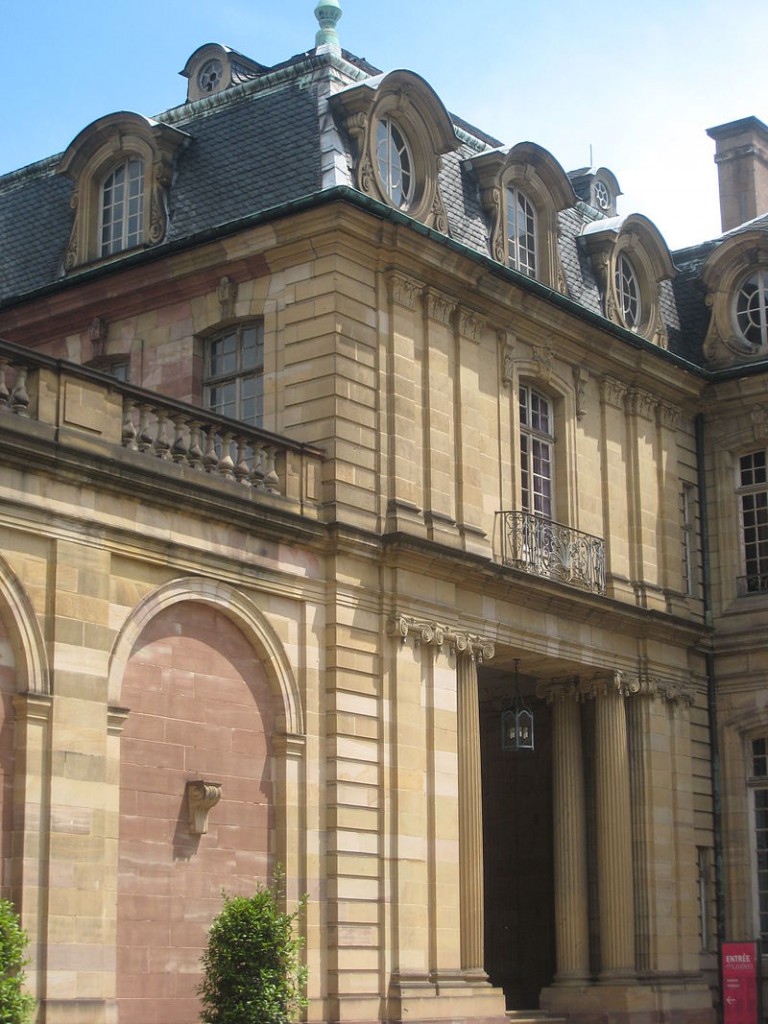
Entrance to the museums (seen in 2008) / 進入博物館(見於2008年)
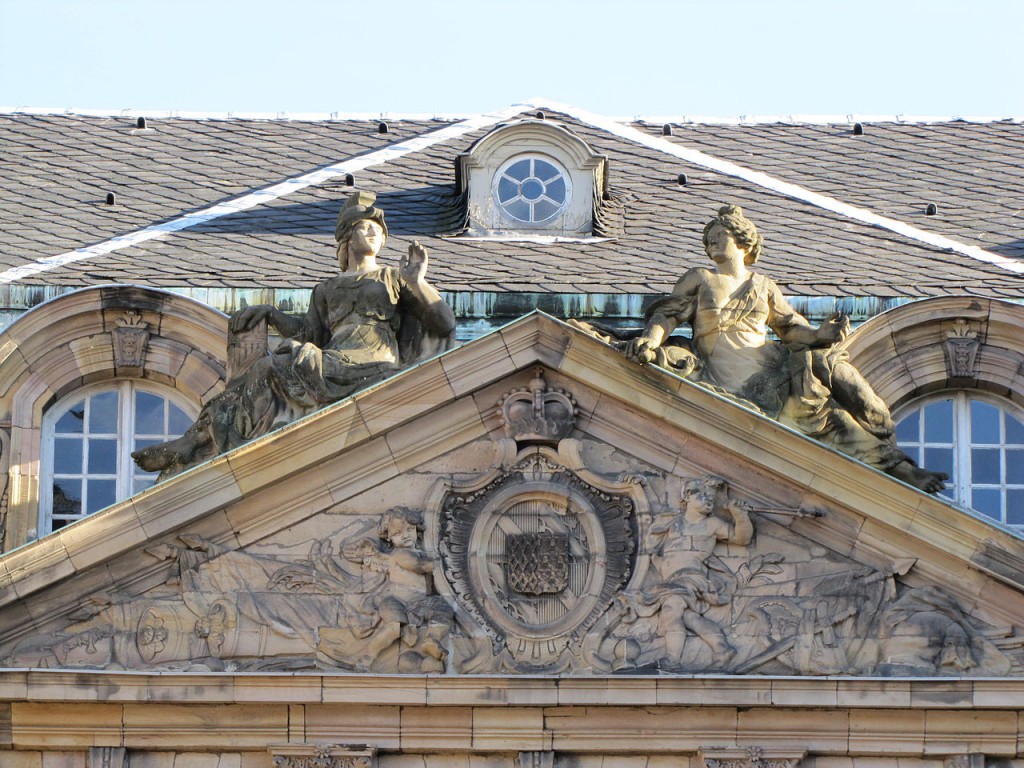
Pediment with coat of arms of the courtyard façade / 帶有徽章的庭院外牆的山形牆

Entrance of the palace
宮殿的入口
Since 1871
he year 1871 signified the end of French rule and the beginning of German rule over Alsace, which had until 1681 been linked to Germany through the Holy Roman Empire. Having lost the Franco-Prussian War, France had to cede the departments of Bas-Rhin, Haut-Rhin, and Moselle (the territory also known as Alsace-Lorraine, or Elsass-Lothringen in German) to the newly created German Empire. Now under new administration and having lost its residential purpose, the Palais Rohan had to be assigned a new role. Between 1872 and 1884, until the opening of the Palais universitaire, it was used by the newly established Kaiser-Wilhelms-Universität, the Imperial German version of the University of Strasbourg, as the seat of the faculties of law, philosophy, and sciences.The palace then served as the university’s library until the opening of the National and University Library in 1895. After this, the palace again became the property of the city and was adapted to receive the municipal art collections that were being built up again by director Wilhelm von Bode after their total destruction during the Siege of Strasbourg (see below, Musée des beaux-arts). The first section of the new Kunstmuseum der Stadt Strassburg, established in 1898, was inaugurated in 1899.
After the return of Alsace to French rule in 1918, the new director of the Musée des beaux-arts and the Musée des arts décoratifs, Hans Haug (1890–1965), put major efforts into presenting the Palais Rohan as a coherent whole again.Strasbourg suffered during World War II, and on 11 August 1944 the palace was damaged by British and American bombs.After the war, restoration measures were soon undertaken under the supervision of the architects Robert Danis (1879–1949) and Bertrand Monnet (1910–1989), but in 1947 a fire broke out and devastated a significant part of the collections of the Museum of Fine Arts. This fire was an indirect consequence of the bombing raids: because of the destruction inflicted on the palace, the building had suffered from damp, which was treated with welding torches, and poor handling of these caused the fire.
Rebuilding and refurbishing the palace took until well into the 1950s, with full restoration not completed until the 1990s.In 1989 a large trompe-l’œil fresco depicting the Roman goddess Ceres was rediscovered behind layers of plaster and white paint in the former dining hall, the eastern wing of the Synod Hall (see below, Apartments). It is thought to have been concealed under Napoleonic ownership, and had been forgotten since.
自1871年以來
他在1871年意味著法國統治的終結和德國統治阿爾薩斯的開始,直到1681年才通過神聖羅馬帝國與德國聯繫。在失去了法國 – 普魯士戰爭之後,法國不得不將Bas-Rhin,Haut-Rhin和Moselle(也稱為Alsace-Lorraine,或德國的Elsass-Lothringen)的部門交給新成立的德意志帝國。現在在新的管理下並且失去了住宅用途,Palais Rohan必須被賦予新的角色。在1872年至1884年之間,直到Palais universitaire開放,它被新成立的Kaiser-Wilhelms-Universität(斯特拉斯堡大學的德國帝國版本)用作法律,哲學和科學學院的所在地。宮殿隨後成為大學的圖書館,直到1895年國立大學圖書館開放。此後,宮殿再次成為城市的財產,並適應接收由威廉主任再次建立的市政藝術收藏品。 von Bode在斯特拉斯堡圍城完成毀滅之後(見下文,Muséedesbeaux-arts)。建於1898年的新藝術博物館斯特拉斯堡的第一部分於1899年落成。
在1918年阿爾薩斯回歸法國統治後,新的藝術博物館和藝術博物館的主任漢斯·豪格(1890-1965)將重要的努力再次展示為羅漢宮。斯特拉斯堡在第二次世界大戰期間遭受了損失,並且在1944年8月11日,宮殿被英國和美國的炸彈炸毀。戰爭結束後,很快在建築師羅伯特·丹尼斯(1879-1949)和伯特蘭·莫內(1910-)的監督下進行了恢復措施。但是在1947年,火災爆發並摧毀了美術博物館收藏的很大一部分。這次火災是轟炸襲擊的一個間接後果:由於宮殿遭到破壞,建築物遭受潮濕,用焊槍處理,對這些火災的處理不當導致火災。
宮殿的重建和整修一直持續到20世紀50年代,直到1990年代才完全恢復。1989年,在前食堂裡,一幅描繪羅馬女神Ceres的大型錯視壁畫被重新發現在石膏和白色油漆層後面。 ,宗教會堂東翼(見下文,公寓)。人們認為它被隱藏在拿破崙的所有權之下,並且從那時起就被遺忘了。

The palace on 5 October 1744, during a visit of King Louis XV of France
1744年10月5日,在法國國王路易十五訪問期間的宮殿
Structure
The palace is structured around a large and paved courtyard. It has a trapezoidal plan, and the land falls away toward the river Ill. To compensate for the slope, the riverside (southern) façade of the main wing has four floors (including the Mansard roof), while the courtyard (northern) façade has three floors. The half-buried floor corresponds to the basement and now houses the archaeological museum (see below, Museums). The riverside façade is thus both the highest and the widest of the palace. The terrace before it, facing the quai des Bateliers, is closed at both ends by elaborate wrought-iron gates adorned with the coat of arms of the House of Rohan.
The riverside façade is formed by the main residential bulk and the library wing on the west side, which offers a contrast in shape and design, notably through its single, very large window. The main part of the façade is symmetrically arranged around an avant-corps of four columns with Corinthian capitals. The avant-corps is crowned with a voluminous triangular pediment, again adorned with the coat of arms of the House of Rohan, while the library wing is crowned with a semicircular pediment. That pediment was originally surmounted by two copper statues of angels, now lost.The library wing was not part of the original 1727 plan but was conceived in 1733, after the cardinal bought up and demolished a row of houses on the current rue de Rohan. The architect, Robert de Cotte, was thus able to distribute the interior spaces of the residential bulk on an even grander and also more practical plan, notably putting the main staircase to the left (east) of the apartment wing instead of the centre.
The courtyard façade of the main wing, in the same classical style as its counterpart facing the Ill, is narrower. A strong emphasis is put on the verticality of the windows, by which means the impression of height is accentuated. Again, a central avant-corps is crowned with a triangular pediment bearing reliefs and in this case also statues. Both façades are richly decorated with allegorical mascarons (depicting seasons, temperaments, continents and elements), eighteen in all on the riverside façade and nine in all on the courtyard façade, to which the riverside façade adds a pair of broad wrought-iron balconies. Due to the difference in width and the trapezoidal plan, the centres of the façades are not aligned.
The courtyard is divided in three sections separated by a row of arches. The left section (as seen from the cathedral) belongs to the Communs wing, which housed the servants. The right section belongs to the stables wing. Left and right of the façade are exedras decorated with busts of Roman emperors. The entrance to the palace is through the left exedra. Facing the courtyard façade is a peristyle with five arches. The central arch, the highest and widest, faces the centre of the façade and opens on the palace’s main gate.
The front of the palace on Place du Château (called Place de l’Évêché between 1740 and 1793), designed in a more Baroque style than the rest of the palace, is wide and curved. The central gate is framed by two pairs of columns and juts out in the shape of a Triumphal arch. The upper part of the front section is crowned with statues representing allegories of faith such as “Religion” and “Eucharist”, and personifications of Christian virtues such as “Mercy” and “Penance”. Plaster casts of some of these statues are displayed in the lapidarium inside the Barrage Vauban. The wooden portal (oak) and the walls east and west of the gate are decorated with trophies and heraldic symbols relating to the House of Rohan and the episcopal polity. The two pavilions connecting the Communs and the stable wings with the gate section are decorated with sixteen mascarons representing male and female Old Testament prophets, and with crescent-shaped pediments, in contrast to the triangular pediments of the façades. The east (left) pavilion housed the palace’s kitchens while the west (right) pavilion housed the offices of the ecclesiastical court.
結構體
宮殿圍繞著一個大型鋪砌的庭院而建。它有一個梯形的平面,土地朝著伊利諾伊河流去。為了彌補斜坡,主翼的河邊(南部)立面有四層(包括曼薩德屋頂),而庭院(北部)立面有三層樓。半埋的地闆對應地下室,現在是考古博物館(見下文,博物館)。因此,河畔的外觀是宮殿中最高和最寬的。前面的露檯面向quai des Bateliers,兩端由精心製作的鍛鐵大門封閉,裝飾著Rohan House的徽章。
河邊的外立面由主要的住宅區和西側的圖書館翼形成,形狀和設計形成鮮明對比,特別是通過其單一的非常大的窗戶。立面的主要部分對稱地圍繞著四個帶有科林斯式大寫字母的前衛軍團。前衛的軍團上裝飾著一個巨大的三角形山形牆,再次裝飾著羅漢家族的徽章,而圖書館的翼上則加上了一個半圓形的山形牆。這個山形牆最初被兩個天使銅雕像所覆蓋,現在已經丟失了。圖書館的翼不是最初的1727計劃的一部分,而是在1733年,在紅衣主教買下並拆除當前rue de Rohan的一排房屋之後構思的。因此,建築師羅伯特·德科特(Robert de Cotte)能夠將住宅區的內部空間分佈在更加宏偉且更實用的計劃上,特別是將主樓梯放在公寓翼的左側(東側)而不是中心位置。
主翼的庭院外觀與面對Ill的對應的古典風格相比,更窄。重點強調窗戶的垂直度,這意味著高度的印象更加突出。同樣,一個中央前衛隊伍加上一個帶有浮雕的三角形山形牆,在這種情況下還有雕像。兩個外立面都裝飾著寓言性的mascarons(描繪季節,氣質,大陸和元素),河畔外觀共有十八個,庭院外牆共有九個,河畔外觀增添了一對寬闊的鍛鐵陽台。由於寬度和梯形平面的不同,立面的中心不對齊。
庭院分為三個部分,由一排拱門隔開。左側(從大教堂看)屬於Communs翼,裡面是僕人。右側屬於馬厩翼。外牆的左側和右側是exedras,裝飾著羅馬皇帝的半身像。宮殿的入口是通過左邊的exedra。面向庭院的外立面是一個帶五個拱門的柱廊。中央拱門,最高和最寬,面向外立面的中心,並在宮殿的正門打開。
ChateauduChâteau宮殿的前面(1740年至1793年間稱為Place de l’Évêché),設計風格比宮殿的
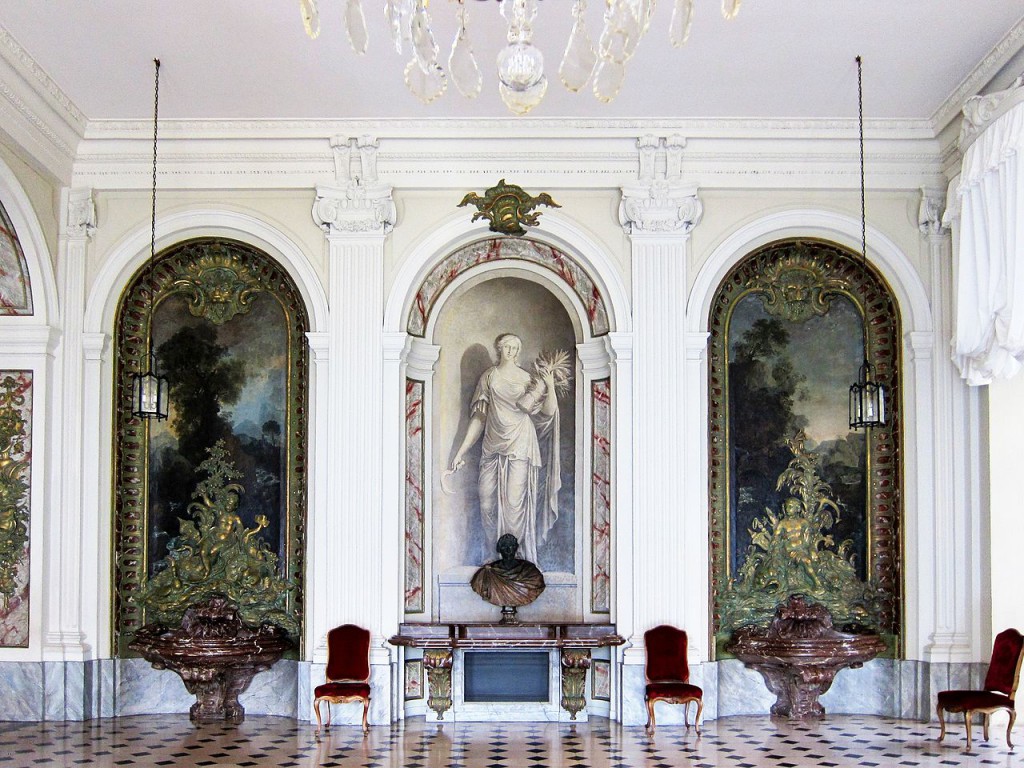
Fresco depicting Ceres, rediscovered in 1989
壁畫描繪了Ceres,於1989年重新發現
Apartments
Gilded stucco in the Bedchamber of the King
The apartments on the piano nobile today form a part of the Musée des arts décoratifs.
The chambers of the prince-bishops and cardinals of the House of Rohan are divided into the grand appartement (display space, facing the river, or south) and petit appartement (living space, facing the inner court and the cathedral, or north), as in the Palace of Versailles. On either side of the suites are the two most spacious rooms of the palace, the Synod Hall (a single, vast room composed of the dining hall and the guards’ hall, separated by a row of arches) and the library, which both extend over the entire longitudinal axis of the wing. The library also serves as the nave of the palace’s very small chapel. The grand appartement is composed of the Salle des évêques (Bishops’ Hall) – the former Antichambre du roi – the Chambre du roi (Bedchamber of the King), the Cabinet du roi (Cabinet of the King), also known as the Salon d’assemblée (Assembly Room) and the Garde-robe du roi (Cloakroom of the King). The “petit appartement” is composed of the Antichambre du prince-évêque, the Chambre du prince-évêque, the Cabinet du prince-évêque (turned into Napoleon’s bedchamber after 1800) and the Garde-robe du prince-évêque. The castle’s garderobe (Cabinet de commodités) is situated next to the cloakroom of the prince-bishop. The interiors were designed according to the decorative principles established by Jacques-François Blondel in his influential book De la distribution des maisons de plaisance et de la décoration des édifices en général (1738), and the stucco and boiseries were influenced by the style of Nicolas Pineau.
Many of the original furnishings were sold in the wake of the French Revolution. Some works of art, including the overdoors from the Salle des évêques, part of the municipal collections, were destroyed with the museum situated in the Aubette when the Prussian Army shelled the city during the Siege of Strasbourg in 1870. In the 20th century and especially during the reconstruction following the bomb damage of August 1944, a great deal of effort went into locating the surviving missing objects and replacing the lost works with identical or similar pieces. They were supervised by the aforementioned Hans Haug, who had become director of the newly created network of the municipal museums on 1 January 1945. Some elements, though, were never restored, such as the stucco of the library. It was lost in 1817 because of leaks through the ceiling; as the only free-standing part of the building, the library has a flat roof.
Among the works of art on view in the apartments, several stand out for their artistic and historic value. The set of eight (originally nine) tapestries depicting “The Story of Constantine” was woven around 1624 after modellos by Rubens. It had been commissioned by Louis XIII of France, who later presented it to the Marquis of Cinq-Mars. Three tapestries are displayed in the Chambre du roi, one in the Cabinet du roi, and four in the library. The set of eight 17th-century Italian busts of Roman emperors in the Salle des évêques belonged to the personal collection of Cardinal Mazarin. Both sets of works were bought in 1738 from the respective heirs by Armand Gaston de Rohan.Another bust of particular value is the marble portrait of Armand Gaston, sculpted in 1730–1731 in Rome by Edmé Bouchardon. It is also displayed in the library. The floor of the chapel is partly covered with a 1745 imitation of a Turkish carpet, woven in the Aubusson manufactory and bearing in its centre the coat of arms of Armand Gaston de Rohan.The carpet covering the large table in the middle of the library was woven in Portuguese India around 1730. It was given to the Cathedral chapter after 1806 and sold to the Musée de Cluny in 1865 but was returned to the city of Strasbourg on permanent loan in 1939. On display in most of the rooms are surviving works from Louis René de Rohan’s vast collection of Japanese vases and Chinese pottery and lacquerware from the Ming and Qing dynasties, originally destined for the new castle in Saverne. A curio cabinet in the Garde-robe du prince-évêque displays dessert tableware from the Manufacture de Sèvres, made in 1772–1774 for Louis-René de Rohan’s special embassy in Vienna. These items now belong to the Musée des arts décoratifs.
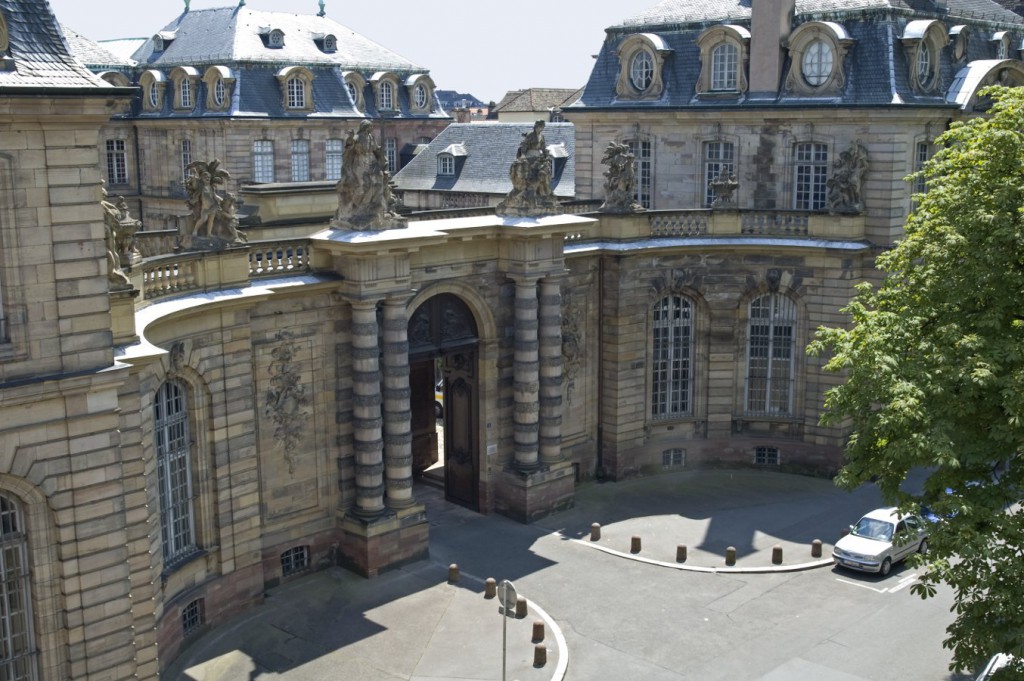
公寓
在國王的臥室裡鍍金的灰泥
今天鋼琴上的公寓是Muséedesartsdécoratifs的一部分。
羅漢府的主教和紅衣主教的分庭分為大公寓(展示空間,面向河流或南方)和小公寓(生活空間,面向內院和大教堂,或北),就像凡爾賽宮一樣。套房兩側是宮殿最寬敞的兩個房間,一個單獨的大房間,由餐廳和衛兵大廳組成,由一排拱門隔開)和圖書館,兩者都延伸在機翼的整個縱軸上。圖書館也是宮殿的小教堂的中殿。宏偉的公寓由Salledesévêques(Bishops’Hall) – 前Antichambre du roi – Chambre du roi(國王的臥室),內閣du roi(國王的內閣),也被稱為沙龍d組成。 ‘assemblée(會議室)和Garde-robe du roi(國王的衣帽間)。 “小公寓”由Antichambre du prince-évêque,Chambre du prince-évêque,Cabinet du prince-évêque(1800年後變成拿破崙的臥室)和Garde-robe du prince-évêque組成。城堡的garderobe(Cabinetdecommitités)位於王子主教的衣帽間旁邊。室內設計是根據雅克 – 弗朗索瓦·布隆德爾(Jacques-FrançoisBlondel)在其有影響力的著作“De la distribution des maisons de plaisance et dedecécorationdesédificesenénéral”(1738)中建立的裝飾原則設計的,灰泥和木製品受到尼古拉斯風格的影響。皮諾。
許多原始家具都是在法國大革命之後出售的。 1870年斯特拉斯堡圍城期間,當普魯士軍隊轟炸城市時,一些藝術品,包括來自Salledesévêques的過度門戶,是市政收藏品的一部分,被摧毀了位於Aubette的博物館。在20世紀,特別是在1944年8月炸彈爆炸事件發生後的重建期間,為了找到倖存的遺失物品並用相同或類似的碎片替換丟失的作品,付出了大量的努力。他們由前面提到的Hans Haug監督,他於1945年1月1日成為新建的市立博物館網絡的主任。但是,有些元素從未恢復過,例如圖書館的灰泥。它在1817年因天花板洩漏而丟失;作為建築中唯一的獨立部分,圖書館有一個平屋頂。
在公寓中的藝術作品中,有幾個因其藝術和歷史價值而脫穎而出。描繪“君士坦丁的故事”的八套(原本九幅)掛毯是在魯本斯的模型後於1624年編織的。它由法國路易十三委託,後來將其提交給了Cinq-Mars侯爵。 Chambre du roi展出三個掛毯,一個位於Cabinet du roi,另外四個位於圖書館。 Salledesévêques的八個17世紀意大利羅馬皇帝半身像屬於紅衣主教馬薩林的個人收藏。這兩套作品於1738年由Armand Gaston de Rohan從各自的繼承人手中購買。另一個特別有價值的半身像是Armand Gaston的大理石畫像,由EdméBouchardon於1730-1731在羅馬雕刻而成。它也顯示在庫中。教堂的地板部分覆蓋著1745仿土耳其地毯,在Aubusson工廠編織,其中心是Armand Gaston de Rohan的徽章。地毯覆蓋在圖書館中間的大桌子上。在1730年左右在葡萄牙印度編織。它於1806年後被送到大教堂章節,並於1865年賣給了MuséedeCluny,但在1939年被永久借給了斯特拉斯堡市。大部分房間展出的都是倖存的作品。 LouisRenédeRohan的大量日本花瓶以及明清兩代的中國陶器和漆器,最初用於Saverne的新城堡。 Garde-robe du prince-évêque的古董櫃展示了1772年至1774年為Louis-RenédeRohan在維也納舉行的特別大使館製作的deSèvres製造商的甜點餐具。這些物品現在屬於Muséedesartsdécoratifs。
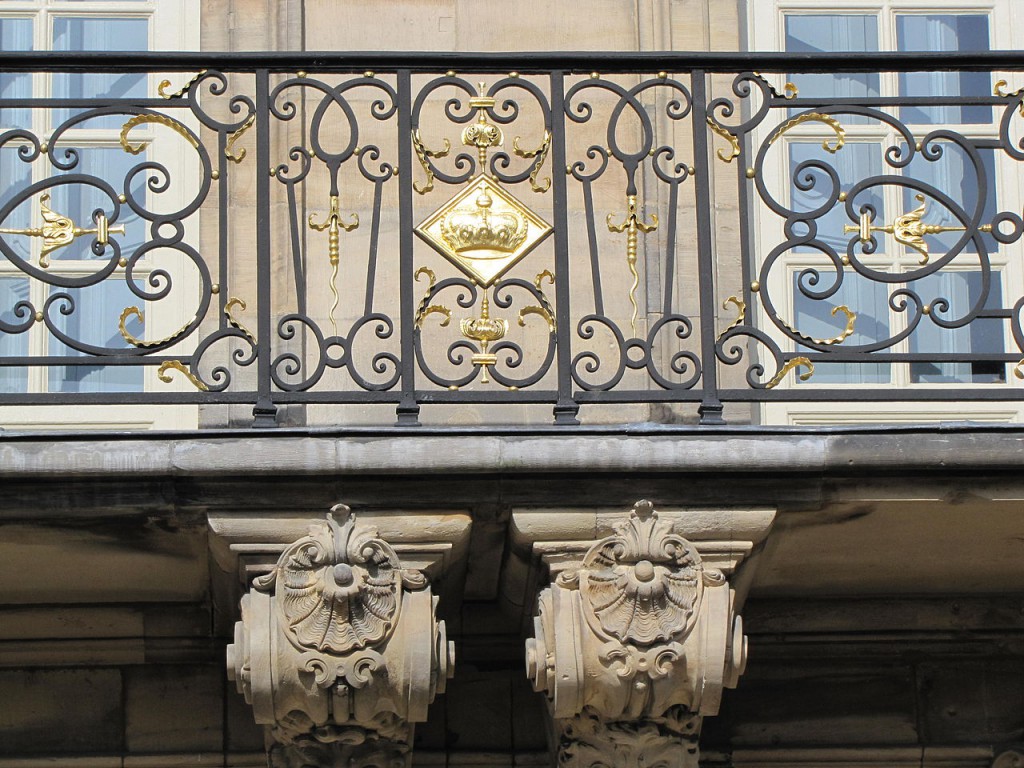
Detail of a wrought iron balcony 一個鍛鐵陽台的細節

Bedchamber of Napoleon in the Empire style
拿破崙的臥室在帝國風格

Painting by Jean-Baptiste Oudry (1742) in the Synod hall / Jean-Baptiste Oudry(1742年)在宗教會堂中繪畫

Canopy bed in the King’s bedchamber / 國王臥室的天蓬床

Synod hall / 會堂

1660s cabinet from Florence, Italy in the Prince-bishop’s antechamber
1660年代的意大利佛羅倫薩內閣,位於Prince-bishop的前廳

18th-century tiled stove in the Prince-bishop’s antechamber
Prince-bishop’s前廳的18世紀瓷磚爐灶

A mascaron depicting Cybele on the riverside façade
在河邊的外牆上描繪Cybele的mascaron
Le Palais Rohan – Région Alsace – Le Monument Préféré des Français
From: Le Monument préféré des Français
The above article is purely for appreciation and sharing purposes, as well as the construction of new technology and the public can be in-depth understanding of the information at the same time there are sources, will be able to query, no use of the document as a commercial transaction, if illegal, please inform the We will immediately remove the site, thank you for cooperation.
以上文章純粹作為欣賞及分享用途,以及將建築新型技術傳遞給與大眾能夠深入了解,同時資料還有來源,將可查詢,絕無使用該文件資料作為商業交易行為,如有違法請務必告知該網站我們將立即處理撤除,謝謝合作。

